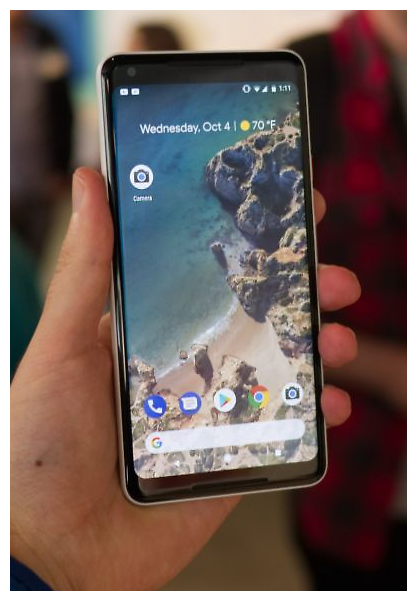Hands on: Google Pixel 2 XL review
TechRadar – By: Cameron Faulkner:
OUR EARLY VERDICT
Despite losing the cherished 3.5mm headphone jack, the Pixel 2 XL seems to have gained more than enough to make up for it thanks to a mix of unique and sought-after features like waterproofing, Active Edge and a truly impressive camera.
 FOR
FOR
Stock Android feels more unique with Active Edge
Confident design
Amazing camera
Waterproof
AGAINST
Price increased over 2016 model
Specs don’t move the needle
No 3.5mm headphone port
After an incredible year for smartphones, which so far has seen the launch of the Samsung Galaxy S8, iPhone X, LG V30, Essential Phone and many more boundary-pushing entries, Google is up to bat for the last big hit of 2017.
And today it took a mighty swing by announcing the Google Pixel 2 and Google Pixel 2 XL, both of which reshape and polish the already-impressive 2016 Pixel devices, but not without a little controversy.
Focusing on the Pixel 2 XL, the company clearly put some effort into making something more than just a larger version of the Pixel 2, as it did last year. In fact, this plus-sized phone visually stands out next to its smaller kin to such a degree that it might as well be a whole new product line.
It’s not just the outside of the phone that has us excited. The specs, including the Snapdragon 835 processor, improvements made to the camera and the intriguing Active Edge feature, look to put it up against (and in some regards, beat down) the toughest round of competition ever put forward by leading manufacturers.
But as always, it comes down to this question: is the phone worth the cost?
When it launches worldwide later this year, the Pixel 2 XL will ship for the hiked-up price of US$849/AU$1,399 (about £630) for the base 64GB model, while the 128GB is priced at US$949/AU$1,549 – we’re getting close to the ceiling in terms of prices set by the Samsung Galaxy Note 8 and iPhone X.
We’ve had some time with Google’s latest at its big event, and leading into our full review, we’ll be updating this post with new impressions as we use the device, fresh photo samples and comparisons and more, so stay tuned.
Design, display and Active Edge
Even if it was pure coincidence, the original Pixel XL certainly blended nicely into the crowd of iPhones, thanks to its generous bezels top and bottom. However, in the year following its debut, this style has quickly gone out the window in favor of the bezel-less look, with even Apple opting for a high screen-to-body ratio with the iPhone X.
So, rather than risk of getting left behind in the last big announcement of the year, it makes sense that the Google Pixel 2 XL would adopt a similar look. And what a refresh this is. Compared to the smaller 5-inch Google Pixel 2, the larger 6-inch version, which now costs a whopping $200 more, provides a decent amount of reason for the price madness.
Starting with the bezels (or the lack thereof), Google’s new phone mostly clears them from view to put the focus on the display – an improved P-OLED display that features a polarized display that can be viewed easily with sunglasses.
Not surprisingly, the new device improves on the original’s with the 2,880 x 1,440 resolution (QHD+), which makes it, once again, the better of Google’s two 2017 options for virtual reality via the Google Daydream View headset.
On its face, the Pixel 2 XL’s bezel layout makes for a similar look to the LG V30 and LG G6. Given that very company poured work into the latest Google phablet, this comes as little surprise, and thankfully, the Pixel 2 XL stands out easily so that you won’t confuse the phones.
Tearing our eyes away from the display (admittedly, a hard thing to do), the rest of the phone has received some big updates that are worth mentioning.
First, let’s address the elephant in the room: neither the Pixel 2 or the Pixel 2 XL feature a 3.5mm headphone jack. These aren’t the first Android phones to omit the legacy port, but given that it made a pointed jab at Apple for doing so last year, there’s a bit of egg on Google’s face right about now.
However, it’s less than you might think given that Android Oreo supports plenty of high-quality wireless audio codecs. This doesn’t excuse the decision, but as opposed to citing “courage” as its inspiration, Google appears to have accounted for the change by working to solve the greater issue of a bad wireless experience, which we’re all for. Plus, it’s tossing a 3.5mm to USB-C adaptor in the box.
Additionally, it has announced the Google Pixel Buds, which could be a good wireless solution if you happen to have $159 around. They’re most interesting than your average headphones though, as they live-translate languages.
Moving right along, the edges of the Pixel 2 XL are rounded off, offering a single, smooth texture instead of the divisive, multi-layered mix of chamfered and glossy metal used in 2016’s model. As usual, the right side of the smartphone plays host to the volume rocker and power button, with each delivering an optimal amount of tactility when pressed.
This sounds like a silly thing to pass judgment on, but in past years the hardware buttons on Nexus phones haven’t yielded the longest lifespan for remaining clicky. Thankfully, we haven’t experienced any issues whatsoever in its Pixel lineup, and this new phone appears to be no exception, though it’s an issue that usually takes months to manifest itself.
Moreover, the Pixel 2 XL features a new button of sorts that’s impervious to whittling away: its Active Edge feature, which lets you squeeze the phone’s frame to issue a command.
Want to boot into the camera app or pull up Google Assistant? Just give the phone a light or hard squeeze, the intensity of which you can determine yourself.
You might remember that this feature first popped up as Edge Sense in the HTC U11, and now it’s been swallowed up in the Pixel 2 XL. While some may stick to using buttons and on-screen prompts, Active Edge is an important new feature that adds a fun, new element of navigation to stock Android, which has the reputation of being a bit stale to some who prefer custom launchers.
Flipped over on its back, the same split, two-toned design of aluminum and glass carries forward into 2017’s Pixel devices, and it’s less divisive than before. My colleagues had some tough words for the original Pixel’s look, calling it “peculiar” and “premium, if slightly odd.” I personally don’t agree, though I can see where they’re coming from. That being said, this melding of materials on the Pixel 2 XL is much more harmonious.
The fingerprint sensor now sits below the glass fold, with only the large rear-facing camera, flash and accompanying sensors sitting within the glass. The slight camera bump might be seen as a flaw to some, but we’re in support of Google raising the camera sensor out a bit, as it prevents the horrors that are endured when the original Pixel’s rear glass cracks.
Performance
Early rumors pointed to the Pixel 2 and Pixel 2 XL being the first phones to launch with a next-gen Snapdragon processor, but that didn’t come to pass. Alas, both smartphones feature 2017’s go-to flagship workhorse, the Snapdragon 835.
Paired with 4GB of RAM, the Pixel 2 XL might not seem like it’s gunning for prime position in the numbers race, but of course we’ve yet to see what this phone is capable of in real-world testing.
Last year’s Pixel XL is equipped with the Snapdragon 821, and we’re still pretty pleased with the performance eked from it, so given Google’s recent work to build a name for itself in internal chipset development, our guess is that this phone has some unique performance tricks up its sleeve.
Of course, this smartphone will already be ahead of the greater pack of Android flagships at launch thanks to it coming with Android Oreo out of the box. You can expect super-fast boot times, optimized background app usage and, perhaps, a few more interesting Pixel-exclusive features coming down the line as Oreo matures.
The Pixel 2 XL’s camera and battery are well worth a discussion, though we won’t know what each is truly capable of until we spend more time with the phone.
Starting with the cameras, Google has gone the extra mile to make its already-stellar camera even better – it’s a 12MP sensor with an aperture of f/1.8 to capture low-light shots better, whether it be in the haze of night or a dark concert hall. On its front, Google has stuck with an 8MP sensor.
Google showed off its Google Lens and ARCore capabilities, both of which are coming to Pixel first. More to come on that later on, but definitely worth a lengthy discussion.
Moving onto the battery, as surprisingly efficient as the Snapdragon 835 has proved itself to be in the past year, we always like to see more battery in our phones, not less (staring daggers at the Moto Z2 Force.) The Pixel 2 XL has been boosted ever so slightly to 3,520mAh over 3,450mAh used in the original XL.
As a result, the 2 XL is very likely to be the popular choice among those who want to use Daydream for longer and, well, just do everything else for longer, too. We’re asking around about official battery capacity.
We’ll have to perform more testing to see if the pairing of its QHD+ display and larger battery will win out versus the Pixel 2’s 1080p screen and smaller battery, or if we’re looking at equal projected lifespans between the two – something that many have said about the first batch of Pixels.
Early verdict
2017 is a hellish year (in that it’s the best ever) to decide on a new smartphone, and Google certainly hasn’t made it any easier with the Pixel 2 XL.
But thanks to some smart re-configurations on both the design and internals fronts, plus a few extra surprises, like Active Edge and its seemingly killer camera, this smartphone could be the one you’ve been waiting for since, if you’re like me, last year’s Google Pixel.
This new device appears to have made improvements where it needed them most (performance and design,) as well as in areas where it already had a comfortable lead (camera, software).
Despite these welcome additions to the Pixel formula, the most unwelcome ingredient is its new price tag, which starts at $849. The divide between the smaller Pixel 2 is wider now: $200 instead of $120.
Is the jump worth it to you? Until we know for sure how the XL’s battery and chipset perform under pressure, check out our guide that might just help make that very decision an easy one.”
